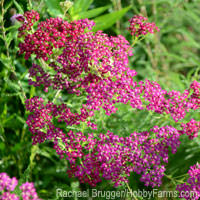
Living in the country, the nearest drugstore can be quite a haul and might not be open when you need it. The beauty of living on a farm surrounded by land untouched by buildings or roads is that you have some of the best medicines right outside your doorstep. Whether you planted them intentionally or they sprung up on their own accord, they can be used to treat bumps, bruises, upset stomachs, bug bites and more—Mother Nature’s own first-aid kit.
When choosing herbs or weeds for medicinal purposes, be sure you know how the plants were grown. Avoid those contaminated by pesticides and other chemicals, and never pick from roadsides. If foraging forests or pastures, take along a trusted guidebook or foraging friend—never ingest a plant unless you’re absolutely sure of its I.D.
Below is a list of readily available plants that can be helpful in treating minor ailments—consult your doctor before continued therapeutic use of any medicinal herbs.
1. Chamomile: Stop Indigestion

Commonly known for its calming properties, chamomile is a gentle-action herb that can be used to treat stomach-related woes in people of all ages, including infants. Also apply a warm chamomile compress or soak in a chamomile-steeped bath to relieve pain and swelling.
2. Comfrey: Stop Pain

If you have an accident-prone family member, comfrey root is for you. It can be used to treat a number of ailments, but perhaps most fascinating is its ability to expedite the healing process when its roots are made into a decoction (i.e., tea) and then used in a compress. Also apply leaves to fresh cuts to stop bleeding and reduce pain.
3. Echinacea: Reduce Inflammation

No matter your source of swelling—be it poison ivy, spider bites, burns, cold or flu—Echinacea, aka purple coneflower, can help. Drink 1/2 cup tea every two hours for acute conditions until symptoms decrease or three times per day for chronic conditions.
4. Lavender: Relieve Stiffness

Steep lavender buds in a tea with other calming herbs, such as lemon balm or chamomile, or alone to treat sunstroke, weakness, swelling and vomiting. Use in a hot compress to relieve pain and stiffness.
5. Plantain: Remove Splinters

Other than dandelions, plantain might be the most common weed in your lawn. Apply a poultice of the chewed or macerated leaves to draw out splinters, stingers, venom and other foreign skin irritants.
6. Purslane: Relieve Headaches

Once regarded as a weed, purslane’s medicinal properties shouldn’t be overlooked. Bruise purslane leaves and place on your forehead to treat headaches caused by dehydration or lack of sleep, or chew a sprig of leaves to quench your thirst while working in the fields.
7. Stinging Nettle: Treat Pain and Burns

Another miracle worker in nature’s medicine cabinet, nettles can be found in abundance on the farm. Wear gloves when harvesting—they call it “stinging” nettle for a reason—and apply the raw leaves, preceded by oil, to areas affected by rheumatism or sciatica to increase circulation and decrease pain. You can also make a standard tea to treat burns or a diluted tea as an astringent gargle.
8. Yarrow: Stop Bleeding

There’s no shortage of things on the farm that cut and scrape, so when you have a gash that won’t stop bleeding, reach for yarrow. Once used to treat bleeding soldiers, the fresh flowers will stop the blood flow almost immediately. You can also mash or chew the leaves into a poultice to treat rashes, or keep a yarrow salve in the medicine cabinet to soothe skin irritations and itchy scabs.
Check out these other herb articles from HobbyFarms.com:
- 12 Edible Flowers That Are Pollinator-friendly, Too!
- Edible Weeds
- Edible Nettle (and Other Uses)
- Using Plants as Medicine
- Keep Garden Pests Away with Companion Planting
- Wildflowers 101




